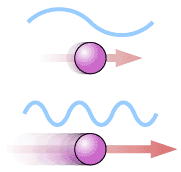|
 |
| Particles with high momentum
have short wavelength. |
|
|
|
The accelerator is today's most
powerful microscope. The resolving power is linked to
the wavelength ( ) of the accelerated
particles, which de Broglie in 1924 showed to be ) of the accelerated
particles, which de Broglie in 1924 showed to be
 = h/p, = h/p,
where h is Planck's constant
and p is the momentum (equal to mv) of the particle.
This formula shows that the larger the momentum the
smaller is the wavelength. Particles accelerated to
high momentum and energy thus have short wavelengths,
which makes it possible to achieve the high
resolution needed to explore the interior of matter.
At high particle energies the interior of matter can
be explored with a resolution that other probes
– like visible light – cannot
achieve.
|